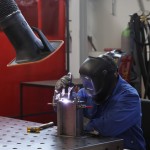Health hazard from welding fumes
Contaminants from welding hold a high potential hazard to the health of welders. This is dependent on welding process and material.
Welding fumes pose an enormous potential hazard. Official tests show that fume particles are typically smaller than 1 micron, and a vast number are even smaller than a tenth of a micron (ultrafine dust particles). All welding fumes are therefore respirable. They penetrate deep into the alveoli when inhaling and lodge there. These particles, e.g. aluminum or iron oxide, then cause strain on the lungs at the very least. Often, however, they are toxic, such as copper, manganese or zinc oxide. Inhaling welding fumes from working with chromium (VI) compounds, lead, titanium or nickel oxides can even lead to cancer.
Process and materials crucial for hazard potential
Health risks arise primarily from the combination of welding processes materials. By choosing processes and materials that produce comparatively little welding fumes, metalworkers can practically eliminate the need for ventilation technology measures. The danger behind the most common processes, inert gas welding (MIG and MAG) and manual arc welding with shielded electrodes (LBH), however, shows the relevance of extraction and filter technology for welding. These processes exhibit a very high hazard potential, regardless of the material being used; in such cases metalworkers must take ventilation technology measures.
Hazards also impair company success
The dangers from being constantly exposed to welding fumes unprotected are not the only things companies and welders themselves should be ashamed of. Common impairments becomes noticeable through fatigue, difficulty breathing, shortness of breath, bronchial diseases, poisoning from manganese, lead or cadmium oxide, or from “metal fever” as it is known, which comes from welding galvanized material. In addition to health hazards, these issues result in sick days and ultimately lower productivity.





